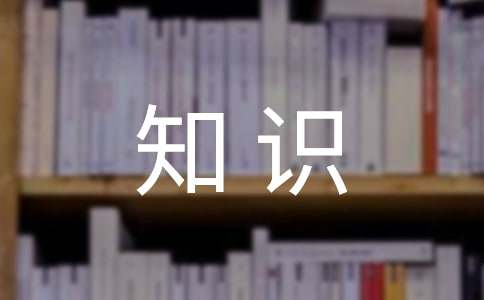小学英语必备的知识重点归纳
对于小学来说,要想学好一门外语并非易事。平时要熟练掌握课文的知识内容,理解语言点和单元语法,勤加复习。下面是百分网小编为大家整理的小学英语必备的知识重点归纳,希望对大家有用!

小学英语重点知识
一、代词:人称代词,物主代词
人称代词物主代词
主格宾格
第一
人称单数I(我)memy(我的)
复数we(我们)usour(我们的)
第二
人称单数you(你)youyour(你的)
复数you(你们)youyour(你们的)
第三
人称单数he(他)himhis(他的)
she(她)herher(她的)
it(它)itits(它的)
复数they(他们/她们/它们)themtheir(他们的/她们的/它们的)
二、形容词,副词:比较级,最高级
(一)、形容词的比较级
1、形容词比较级在句子中的运用:两个事物或人的比较用比较级,比较级后面一般带有单词than。比较级前面可以用more, a little来修饰表示程度。than后的人称代词用主格(口语中可用宾格)。
2.形容词加er的规则:
⑴ 一般在词尾加er ;
⑵ 以字母e 结尾,加r ;
⑶ 以一个元音字母和一个辅音字母结尾,应双写末尾的辅音字母,再加er ;
⑷ 以“辅音字母+y”结尾,先把y变i,再加er 。
3.不规则形容词比较级:
good-better, beautiful-more beautiful
(二)副词的比较级
1.形容词与副词的区别(有be用形,有形用be;有动用副,有副用动)
⑴在句子中形容词一般处于名词之前或be动词之后
⑵副词在句子中最常见的是处于实义动词之后
2.副词比较级的变化规则基本与形容词比较级相同(不规则变化:well-better, far-farther)
小学英语必考知识
冠词
不定冠词,定冠词种类:
(1)不定冠词:a / an a unit / an uncle
元音开头的可数名词前用an :
an egg / an apple / an orange / an eraser / an answer / an ID card / an alarm clock / an actor / an actress / an e-mail / an address / an event / an example / an opera / an houran old man / an interesting book / an exciting sport / an action movie / an art lesson /
(2)定冠词:the the egg the plane
2. 用法:
定冠词的用法:
(1)特指某(些)人或某(些)物: The ruler is on the desk.
(2)复述上文提到的人或物:He has a sweater. The sweater is new.
(3)谈话双方都知道的人或物:The boys aren’t at school.
(4)在序数词前: John’s birthday is February the second.
(5)用于固定词组中: in the morning / afternoon / evening
不用冠词的情况:
(1)专有名词前:China is a big country.
(2)名词前有定语:this , that , my , your , some, any , no 等:
This is my baseball.
(3)复数名词表示一类人和事:Monkeys can’t swim. They are teachers.
(4)在节日,日期,月份,季节前:Today is Christmas Day. It’s Sunday.
(5)一日三餐前:We have breakfast at 6:30.
(6)球类 棋类运动前:They often play football after class. He plays chess at home.
但乐器前要用定冠词:I play the guitar very well.
(7)学科名称前:My favorite subject is music.
(8)在称呼或头衔的名词前:This is Mr Li.
(9)固定词组中:at noon at night by bus
小学英语基础知识
数词:基数词、序数词
基数词
(1)1-20
one,two,three,four,five,six,seven,eight,nine,ten,eleven,twelve,thirteen,fourteen,fifteen, sixteen,seventeen,eighteen,nineteen,twenty
(2)21-99 先说“几十”,再说“几”,中间加连字符。
23→twenty-three,34→thirty-four,45→forty—five,56→fifty-six,67→sixty-seven,78→seventy-eight,89→eighty-nine,91→ninety-one
(3)101—999先说“几百”,再加and,再加末两位数或末位数;
586→five hundred and eighty-six,803→eight hundred and three
(4)l,000以上,先从右往左数,每三位数加一个“,”,第一个“,”前为thousand.第二个“,”前为million,第三个“,”前为billion
1,001→one thousand and one
18,423→eighteen thousand,four hundred and twenty-three
6,260,309→six million two hundred and sixty thousand three hundred and nine
750,000,000,000→seven hundred and fifty billion
序数词
(1)一般在基数词后加th
eg.four→fourth,thirteen→thirteenth
(2)不规则变化
one→first,two→second,three→third,five→fifth,eight→eighth,nine→ninth,twelve—twelfth
(3)以y结尾的十位整数,变y为ie再加th
twenty→twentieth, forty→fortieth, ninety→ninetieth
(4)从二十一后的“几十几”直至“几百几十几”或“几千几百几十几”只将个位的基数词变为序数词。
twenty-first,two hundred and forty-fifth
小学英语重要的知识点
短语:
1.the first day第一天
2.the new term新学期
3.all the students所有学生
4.at school在学校
5.each other互相
6.a new building一幢新教学楼
7.a lot of rooms许多房间
8.how many多少
9.two reading rooms两间阅览室
10.have a look看一看
11.go and play去玩
12.go and see.去看看
13.go and have a look看一看
14.a lot of flowers and trees许多花和树
15.good idea好主意
16.in the street在街道上
17.on the plate在盘子里
18.on the table在桌子上
句子
1.Is there a garden in the school?No,there isn’t.
学校里有个花园吗?不,没有。
2.Is there a reading room near the playground?Yes,there is.
操场附近有个阅览室吗?是的。
3.Are there any bookcases near the window?No,there aren’t.
窗子附近有一些书橱吗?不,没有。
4.Are there any pictures on the desk?Yes,there are.课桌上有一些图片吗?是的。
5.How many TV rooms are there in the building?There are four.
大楼里有几间电视房?有四间。
6.I’m not sure.我不能确定。
小学生英语期末考试名词知识
一、定义
名词是表示人或事物名称的词。它既可以表示具体的东西,也可以是表示抽象的东西。
二、分类
1.名词可以根据意义分为普通名词和专有名词
如:John is a student.
student是普通名词,John是专有名词
普通名词前可以用不定冠词a/an,定冠词the或不加冠词,专有名词前一般不加冠词,专有名词的首字母要大写。
2.普通名词又可以分为个体名词、集体名词、物质名词和抽象名词,其中个体名词与集体名词是可数名词,物质名词和抽象名称是不可数名词。
3.专有名词
专有名词是表示人名、地名、团体、机构、组织等的专有名词,多为独一无二的事物。
三、名词的数
1、名词分为可数名词和不可数名词。
可数名词——可以数的名词
不可数名词——数不清(没有复数)
Drink? milk, tea, water ,orange,juice,coke,coffee,porridge.
Food? rice,bread,meat,fish,fruit,cake,dumplings.
2、可数名词与不定冠词a(an)连用有数数形式,不可数名词不能与不定冠词a(an)连用,没有复数形式
many+可数名词复数
much/a little+不可数名词
some,any,a lot of (lots of)两者都可以修饰。
3、可数名词可以直接用数词来修饰
不可数名词数词+量词+of+名词
对可数名词的数量提问用 How many
对不可数名词的数量提问用 How much
4、不可数名词的量有以下两种表示方法:
1)some, much, a little, a lot of,a bit of, plenty of 用等表示多少。
注意既可以与可数名词复数,又可以与不可数名词连用的有:plenty of ,some, a lot of ,lots of, most of 等。
如There is much water in the bottle. 瓶中有很多水。
小学英语重点知识点
1介词on/in用法
on the chair(在椅子上)/in the pencil-box(在文具盒里)/in the desk(在课桌里)/in the sky(空中)
2特殊疑问句用法
①特殊疑问句“where”的用法:
Where is …?(在哪里...?) ----Its on…. / Its in….
②特殊疑问句“what”的用法:
Whats on the table? — A plate of cakes.(桌子上有什么?一盘蛋糕。)
③特殊疑问句“who”的用法:
Who is he/she? He/ She is….(他/她是谁?他/她是...)
They are brother and sister.(他们是兄妹。)
当不知道是谁时,人称代词用it
Who is it? ----- Its me.(他是谁?这就是我。)
“感叹句用what和how: what修饰名词;how修饰形容词
How nice on a ship! How nice!(船上有多好!多好的!)
What a fine day! What a big cake!(多好的天气啊!多大的蛋糕!)”
3let’s 句型:
lets =let us
Lets make a blouse/vest.(让我们做一件衬衫/马甲)
Lets run a race.( 让我们赛跑)/Lets play games.(让我们玩游戏)
Lets ride it.(让我们骑它)
Lets give her nice things.(让我们给她美好的事物)
Lets count the candles.(让我们数蜡烛)
Let me help you.(让我帮助你)
Let me open/close the door.(让我开/关上门)
Let me get the apples/pears.(让我给你苹果/梨)
Lets go home.(让我们回家吧)
4can句型:
We cant let him in.(我们不能让他进来)
She can’t swim.(她不会游泳)
I cant find/see….(我不能找到/看到...)
Can she swim? Yes, she can. / No, she can’t.(她会游泳吗?是的,她可以。不,她不会。)
Can you make cakes? Yes, I can. / No, I cant.(你会做蛋糕吗?是,我会。不,我不会。)
Can you fly it? —Of course,I can.(你会飞吗?-当然,我可以。)
5“have”的用法:
①“have”表示“有”
I have a kite/ a new bike.(我有一个风筝/一辆新自行车。)
We have some nice things for you.(我们有一些好东西给你)
②“have”表示“吃”
Have a coke/an apple. —Yes, thank you./ No, thanks.(喝一杯可乐/一个苹果。是的,谢谢。/不,谢谢。)
Please have the cake. —Thank you.(请吃蛋糕。-谢谢。)
Lets have the good things.(让我们拥有美好的事物。)
【小学英语的知识重点归纳】相关文章:
小学英语重点知识归纳总结12-02
小学英语必备重点知识归纳12-02
小学英语的重点知识点归纳01-22
小学英语重点知识点的归纳01-27
小学英语重点知识点归纳大全01-27
小学英语重点知识点总结归纳11-07
高中英语必备的知识重点归纳12-01
初一英语知识重点归纳总结11-07
初一英语知识重点总结归纳12-03